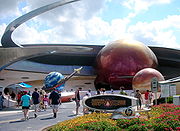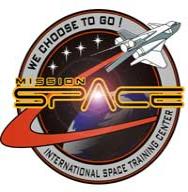| Mission Space |
Mission: SPACE is a motion simulator thrill ride at Epcot. It simulates what an astronaut might experience
aboard a spacecraft on a mission to Mars, from the higher g-force of blastoff to the speculative hypersleep.
The attraction opened to the public in a "soft opening" mode in June 2003, and celebrated its grand opening
on October 9 with a ceremony attended by Disney CEO Michael Eisner, HP CEO Carly Fiorina and NASA
Administrator Sean O'Keefe, as well as several NASA astronauts from its many phases of human space
exploration (Mercury, Gemini, Apollo, the space shuttle program and two crew members aboard the
International Space Station).
The attraction was built on the former site of Horizons, a dark ride that offered optimistic visions of what life
might be like in the future. Horizons closed permanently in 1999 after a few years of sporadic operation;
construction began on Mission: SPACE shortly thereafter. Industry estimates put the cost of developing the
new attraction at US$100 million.
Mission: SPACE is meant to simulate astronaut training for the first manned mission to Mars aboard the
fictional X-2 Deep Space Shuttle in 2036, the seventy-fifth anniversary of Yuri Gagarin becoming the first man in
space. (The year 2036 can be deduced from plaques in the attraction's queue celebrating 75 years of human
spaceflight, including two faux milestones in the future.) Riders are "trainees" at the fictional International
Space Training Center (ISTC), where they are arranged into crews of four before watching an introductory video
featuring actor Gary Sinise, who starred in the space drama, Apollo 13 and Mission to Mars.
Before boarding the simulators, each rider is assigned an on-board role (navigator, pilot, commander or
engineer) and given two tasks to perform during the mission (pressing a specific button when told). For
example, one of the commander's buttons initiates the rocket's first-stage separation, and the other activates
manual flight control. The spacecraft's on-board self-automated pilot will perform each task if the rider does
not respond to his or her prompt from Mission Control or if there is no one to perform the task. Also featured
are various labeled buttons and switches which the rider may play with but do nothing; they are only there to
add to the realism aspect of the ride.
The mission includes liftoff from the ISTC, a slingshot around the moon for a gravity-assisted boost, a brief
period of simulated hypersleep (to pass the lengthy time required to reach Mars) and a descent for landing on
the Martian surface. As a training exercise, the mission contains several unexpected situations that add to the
drama.
The futuristic X-2 vehicle is a three-stage rocket which is said to use several technologies in development
today, including aerospike engines, solid hydrogen fuel, an aerobrake and carbon nanotubes.
The attraction queue contains several items and commemorative plaques from past, present and fictional
future space missions. Among the items on display are props from the 2000 film Mission to Mars, including
the rotating "gravity wheel" from the predecessor X-1 spacecraft, a model of which hangs from the ceiling, and
a replica of a NASA moon rover from the Apollo program.
Upon conclusion of the training exercise, guests are invited to participate in activities at the Advanced Training
Lab, a post-show area containing a group game called Mission: SPACE Race in which players perform tasks
as Mission Control technicians aiding two X-2 spacecraft racing to return to Earth; a space-themed play area
for toddlers; a single-person, arcade-style game in which an astronaut explores Mars on foot; and a kiosk
where brief video postcards can be created and sent via e-mail.
aboard a spacecraft on a mission to Mars, from the higher g-force of blastoff to the speculative hypersleep.
The attraction opened to the public in a "soft opening" mode in June 2003, and celebrated its grand opening
on October 9 with a ceremony attended by Disney CEO Michael Eisner, HP CEO Carly Fiorina and NASA
Administrator Sean O'Keefe, as well as several NASA astronauts from its many phases of human space
exploration (Mercury, Gemini, Apollo, the space shuttle program and two crew members aboard the
International Space Station).
The attraction was built on the former site of Horizons, a dark ride that offered optimistic visions of what life
might be like in the future. Horizons closed permanently in 1999 after a few years of sporadic operation;
construction began on Mission: SPACE shortly thereafter. Industry estimates put the cost of developing the
new attraction at US$100 million.
Mission: SPACE is meant to simulate astronaut training for the first manned mission to Mars aboard the
fictional X-2 Deep Space Shuttle in 2036, the seventy-fifth anniversary of Yuri Gagarin becoming the first man in
space. (The year 2036 can be deduced from plaques in the attraction's queue celebrating 75 years of human
spaceflight, including two faux milestones in the future.) Riders are "trainees" at the fictional International
Space Training Center (ISTC), where they are arranged into crews of four before watching an introductory video
featuring actor Gary Sinise, who starred in the space drama, Apollo 13 and Mission to Mars.
Before boarding the simulators, each rider is assigned an on-board role (navigator, pilot, commander or
engineer) and given two tasks to perform during the mission (pressing a specific button when told). For
example, one of the commander's buttons initiates the rocket's first-stage separation, and the other activates
manual flight control. The spacecraft's on-board self-automated pilot will perform each task if the rider does
not respond to his or her prompt from Mission Control or if there is no one to perform the task. Also featured
are various labeled buttons and switches which the rider may play with but do nothing; they are only there to
add to the realism aspect of the ride.
The mission includes liftoff from the ISTC, a slingshot around the moon for a gravity-assisted boost, a brief
period of simulated hypersleep (to pass the lengthy time required to reach Mars) and a descent for landing on
the Martian surface. As a training exercise, the mission contains several unexpected situations that add to the
drama.
The futuristic X-2 vehicle is a three-stage rocket which is said to use several technologies in development
today, including aerospike engines, solid hydrogen fuel, an aerobrake and carbon nanotubes.
The attraction queue contains several items and commemorative plaques from past, present and fictional
future space missions. Among the items on display are props from the 2000 film Mission to Mars, including
the rotating "gravity wheel" from the predecessor X-1 spacecraft, a model of which hangs from the ceiling, and
a replica of a NASA moon rover from the Apollo program.
Upon conclusion of the training exercise, guests are invited to participate in activities at the Advanced Training
Lab, a post-show area containing a group game called Mission: SPACE Race in which players perform tasks
as Mission Control technicians aiding two X-2 spacecraft racing to return to Earth; a space-themed play area
for toddlers; a single-person, arcade-style game in which an astronaut explores Mars on foot; and a kiosk
where brief video postcards can be created and sent via e-mail.


Show Length: 5:38
Ride Length: 3:55
Height Requirement: 44"
G-Force: 2.5g (sustained)
Number of Centrifuges: 4
Capsules per Centrifuge: 10
Riders per Capsule: 4
Capacity: 1,600 riders per hour
Ride Length: 3:55
Height Requirement: 44"
G-Force: 2.5g (sustained)
Number of Centrifuges: 4
Capsules per Centrifuge: 10
Riders per Capsule: 4
Capacity: 1,600 riders per hour
